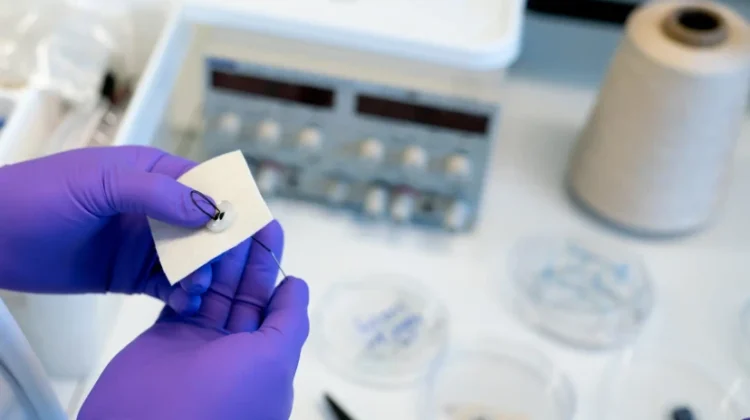
A research group led by Chalmers University of Technology in Sweden has developed a silk thread, coated with a conductive plastic material, that has the potential to turn textiles into electricity generators.
Thermoelectric textiles convert temperature differences, for example between our bodies and the surrounding air, into an electrical potential, which would then be used to power battery-less devices such as medical monitors.
Since the textiles must be worn close to the body, the materials used in them must meet high demands on safety and flexibility. The silk thread that the researchers tested has a coating made of a conducting polymer with a chemical structure that makes the material electrically conductive and well adapted to textiles.
‘The polymers that we use are bendable, lightweight and are easy to use in both liquid and solid form. They are also non-toxic,’ said Mariavittoria Craighero, a doctoral student in the Department of Chemistry and Chemical Engineering at Chalmers University of Technology.
The researchers previously created a similar thread that contained metals to maintain its stability in contact with air. Since then, they have found a way to manufacture the thread with only organic polymers.
‘We found the missing piece of the puzzle to make an optimal thread – a type of polymer that had recently been discovered. It has outstanding performance stability in contact with air, while at the same time having a very good ability to conduct electricity. By using polymers, we don’t need any rare earth metals, which are common in electronics,’ said Craighero.
To show how the new thread can be used in practice, the researchers manufactured two thermoelectric generators – a button sewn with the thread and a piece of textile with sewn-in threads. When they placed the thermoelectric textiles between a hot and a cold surface, they could observe how the voltage increased. The effect depended on the temperature difference and the amount of conductive material in the textile.
As an example, the larger piece of fabric showed about six millivolts at a temperature difference of 30°C. In combination with a voltage converter, it could theoretically be used to charge portable electronics via a USB connector. The researchers have also been able to show that the thread’s performance is maintained for at least a year and is machine washable.
‘After seven washes, the thread retained two-thirds of its conducting properties. This is a very good result, although it needs to be improved significantly before it becomes commercially interesting,’ said Craighero.
The thermoelectric fabric and button currently can’t be produced efficiently outside the lab environment. The material must be made and sewn in by hand, which is time-consuming. Just sewing it into the demonstrated fabric required four days of needlework.
‘We have now shown that it is possible to produce conductive organic materials that can meet the functions and properties that these textiles require. This is an important step forward. There are fantastic opportunities in thermoelectric textiles and this research can be of great benefit to society,’ said Christian Müller, a professor in the Department of Chemistry and Chemical Engineering at Chalmers University of Technology.
The research has been published in Advanced Science.


